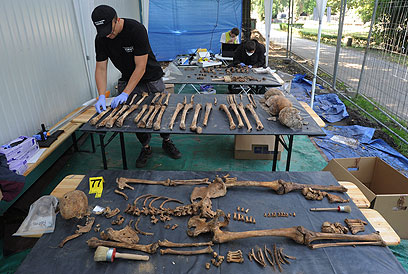 |
| Sicilian Mummies |
Now we all have to admit there is something rather fascinating and horrifying about a mummy. . . Kind of like the way people can't seem to turn away from a train wreck that is about to happen. It is fascinating from a distance, but get in too close (physically or emotionally) and it's a real killer. . . so to speak. Macabre, mummies are full of it, the same way horror films or slasher films do so well in the box office.
But movies are distant they aren't really real. Sometimes they can be based on reality but. . . mummies are real, they, unlike movies were once living breathing humans. There's a thought. . . does that make mummies different. Are mummies that separate from our human reality?
First of what is a mummy? A mummy is essentially a dead human being, that has been extraordinarily preserved as a result of careful prepping or due to weather conditions that has made the decomposition process impossible or incredibly slow. In some cases there are whole catacombs and morgues that are full of these remains. Silent symbols of a past that cannot fully be brought back to life. The ghoulish forms do bring in some imagination into what it could have been like. But generally they make us think more of horror stories and darker unrealistic pasts. There are all kinds groups and people who make get a kick out of making our perception of mummies even worse. Check out this whole tourist thing that is aimed at giving people a tour of the crypts: http://www.sicilianexperience.com/share/http:/www.sicilianexperience.com/share/article/650. The whole thing is focused on the scare and the freak show part.
These remains that were once like us, not covered in rotting flesh but in warm skin and with blood pumping through their now empty veins. Now we make them unlike us, we focus on the freak aspect, because it so counter to what we do with our dead. When people die in our society we don't see them, we don't really preserve them in that way. We memorialize them in pictures or videos, we don't (usually) keep people fully intact underground. People are buried or are cremated. But we really need to learn a bit of respect for the dead. . . These mummies, sure it's cool to go check them out. . . count me in! I would love to see some catacombs. But, we really need to remember that it is so much more than just some ghoulish head staring empty eye-socketed toward us. No that could have been someone's grandmother, their sister, their brother, and as such should be treated with respect.
 No creepy horror film story-line here, no zombie apocalypse old dead guy coming back to life. Because really now, these are people people, and if they came back to life. . . would they really eat your brains or suck your soul? No let's think about this, if they were to come back as they were, let's think some history here. Sicilian mummies were generally of clergy men. So there would be a lot of very religious men living their lives again, probably going right back to working at a church or a monastery or something like that. . . Doing what they did best by serving other's and their god. Now is that a scary mummy? Some nice old dude who wants to help poor starving orphans or old widows who need a place to live? Seriously now, let's give the dead some respect. We can learn all we want about who they were and what they did in their lives, but let's not create some new horror story about them. No, let's give their story the voice of truth.
No creepy horror film story-line here, no zombie apocalypse old dead guy coming back to life. Because really now, these are people people, and if they came back to life. . . would they really eat your brains or suck your soul? No let's think about this, if they were to come back as they were, let's think some history here. Sicilian mummies were generally of clergy men. So there would be a lot of very religious men living their lives again, probably going right back to working at a church or a monastery or something like that. . . Doing what they did best by serving other's and their god. Now is that a scary mummy? Some nice old dude who wants to help poor starving orphans or old widows who need a place to live? Seriously now, let's give the dead some respect. We can learn all we want about who they were and what they did in their lives, but let's not create some new horror story about them. No, let's give their story the voice of truth. 

.jpg)










